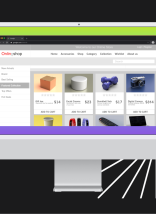During the wonderful pleasure of checking out of a eCommerce website, something shocking happened: I became distracted. What was the website’s shortcoming? A poorly placed call-to-action button? Some user experience faux pas that made me feel under-appreciated as a consumer? A page load time that took milliseconds longer than the time I felt like waiting?
Actually, there was no digital culprit. My wife came in with the groceries. So I stopped shopping to help her put away food.
Even with craftsman-like attention to every nuance of customer experience, life can and does find a way to distract us from purchases we intend to make. In a world of digital noise and constant demands for attention, we shouldn’t be surprised there are so many things that prevent customers from completing an order. I’d argue there are more things that prevent an order from happening than help it.
Adobe Digital Insights estimated only 30% of desktop shopping carts resulted in an order (dropping down to 19% on mobile devices). That same study also surveyed consumers about how they source the best deals for the holidays. Most agreed on email and search ads were the best methods, while social media and app push notifications were the worst.
Whatever methods they use, eCommence retailers need to dig deep and command attention to break through to new sales goals. Constant awareness, presence, and time-sensitive actions are all must-do actions to push sales higher and make people remember why they need that thing you offer.
One Half of a Whole: eCommerce and Marketing Automation
I’m going on the record here: There should be no eCommerce without Marketing Automation.
You know how every movie with ghosts theorizes that spirits come back to haunt us because they have unfinished business on our earthly plane? This is exactly how you should think about marketing automation—as a reanimated specter that reaches from the great beyond and will not be silenced until you complete your transaction (at 15% off with promo code GHOSTLY15).
Here’s the bad news, much of marketing automation is a guessing game. You choose arbitrary dates, subject lines, and emojis to make your email or message appear the most relevant at what you hope is the most relevant time. Many attempts at reaching out to customers will fall flat, but the few glimmering diamonds that manifest will make your marketing automation worth it.
Part of the reason marketing automation is attractive is that robots are very good at consistency. Tell your automation app what kind of simple iterations of repeatable messages you want to send, and you can easily test all kinds of variables to see what drives the most responses. By measuring the experience through automation, you can focus on the results and use them to inform every aspect of your marketing work.

Some basic automations to get you started include:
Cart Abandonment with Discount Offers
This is the most essential marketing automation available. Here’s how it works: someone adds something to their cart, they abandon the cart without purchasing, and your automation app emails them automatically with an offer of a discount on that particular product. You can try this tactic both as an abandoned cart reminder (pinging the customer to finish their purchase) or as a special discount offered at a certain cart threshold (thus encouraging them to add an additional item to their order).
Make no mistake: if someone has added an item to their cart, they want it. They are on the precipice of purchasing, but anything from a crying child to a sudden desire for a ham sandwich could prevent them from making that decision. So your offer has to break through that and encourage them to finish purchasing the item you already know they want.
Activity-Based Engagements
Some customers may not even reach the add-to-cart stage and are still browsing. Here the objective is to remind them of their shopping experience based on particular items they viewed or categories of items that they looked at (e.g. sweaters or video games). Again, tying this to a specific offer or discount based on a total purchase price will encourage more purchases. Don’t forget the power of deadlines to produce results (e.g. “This discount only available for the next 59 minutes.”). Making specific promotional codes expire after a certain period of time drives customers to make a faster decision to avoid losing their deal.
Again, people look for something to nudge them toward a particular decision they already want to make. Make it easy on these weary souls by telling them this purchase is the right move through automations that remind and reaffirm.
New and Trendy
Fear of Missing Out (F.O.M.O) is a powerful siren’s call that easily causes dollars to leave wallets. Framing a temporary trend works with natural herd mentalities can drive more people to do what you want them to do: convert. Getting people caught up in the moment of a seasonal trend introduces a time-honored sales hysteria that can catapult your sales to new heights.
Target customers with frequent purchases from the site to make them aware of new product offerings, trends, styles, and more. Note that it’s important to employ multiple marketing automation flows to relentlessly pursue your target until they succumb to the inevitability of their not-yet-made sale. Place someone into a flow to make them aware of a particular trend, and when they don’t purchase, add them to another automation that makes them a compelling discount offer.
Marketing Automation for Ads: Remarketing
The main challenge of marketing automation is it typically requires an initial form conversion to reengage customers. While it’s not technically MA, dynamic product listing ads allow you to show particular items to your customers via a feed. This reminds them of that particular item they simply forgot to actually purchase. Similar remarketing options exist across social media that act as a touchpoint for bringing people back into the fold.

Unlike marketing automation where you’re using email to physically place a message into something they own (their inbox), you can be more aggressive with remarketing without offending people. Aggressive remarketing can be annoying, but it preys on your sometimes chance of clicking the ad and purchasing the product.
It’s like a loyal dog that likes to watch you eat dinner. The dog can annoy you, but you can’t get that mad at him. It’s in his nature, and he’s super cute. And while you won’t give him your people food all the time, you might give some of your people food sometimes. And he will wait you out because he knows the rules too.
In conclusion, you will never win by hoping your customers don’t get distracted from making a purchase. By relying on a strong marketing automation strategy, you can engage with distracted customers in the midst of their crowded headspace and win them over with the right message. If you have questions about how to implement a marketing automation or eCommerce plan, feel free to contact us.







